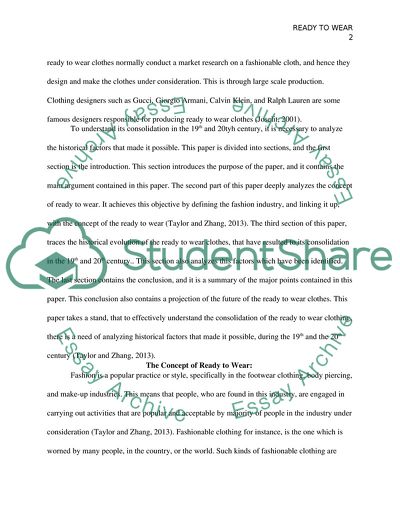Cite this document
(Historical Factors Leading to the Consolidation of the Ready to Wear Essay Example | Topics and Well Written Essays - 3000 words, n.d.)
Historical Factors Leading to the Consolidation of the Ready to Wear Essay Example | Topics and Well Written Essays - 3000 words. https://studentshare.org/design-technology/1850893-explore-the-historical-factors-that-lead-to-either-the-emergence-of-ready-to-wear-in-the-eighteenth-century-or-its-consolidation-in-the-nineteenth-and-early-twentieth-century
Historical Factors Leading to the Consolidation of the Ready to Wear Essay Example | Topics and Well Written Essays - 3000 words. https://studentshare.org/design-technology/1850893-explore-the-historical-factors-that-lead-to-either-the-emergence-of-ready-to-wear-in-the-eighteenth-century-or-its-consolidation-in-the-nineteenth-and-early-twentieth-century
(Historical Factors Leading to the Consolidation of the Ready to Wear Essay Example | Topics and Well Written Essays - 3000 Words)
Historical Factors Leading to the Consolidation of the Ready to Wear Essay Example | Topics and Well Written Essays - 3000 Words. https://studentshare.org/design-technology/1850893-explore-the-historical-factors-that-lead-to-either-the-emergence-of-ready-to-wear-in-the-eighteenth-century-or-its-consolidation-in-the-nineteenth-and-early-twentieth-century.
Historical Factors Leading to the Consolidation of the Ready to Wear Essay Example | Topics and Well Written Essays - 3000 Words. https://studentshare.org/design-technology/1850893-explore-the-historical-factors-that-lead-to-either-the-emergence-of-ready-to-wear-in-the-eighteenth-century-or-its-consolidation-in-the-nineteenth-and-early-twentieth-century.
“Historical Factors Leading to the Consolidation of the Ready to Wear Essay Example | Topics and Well Written Essays - 3000 Words”. https://studentshare.org/design-technology/1850893-explore-the-historical-factors-that-lead-to-either-the-emergence-of-ready-to-wear-in-the-eighteenth-century-or-its-consolidation-in-the-nineteenth-and-early-twentieth-century.


